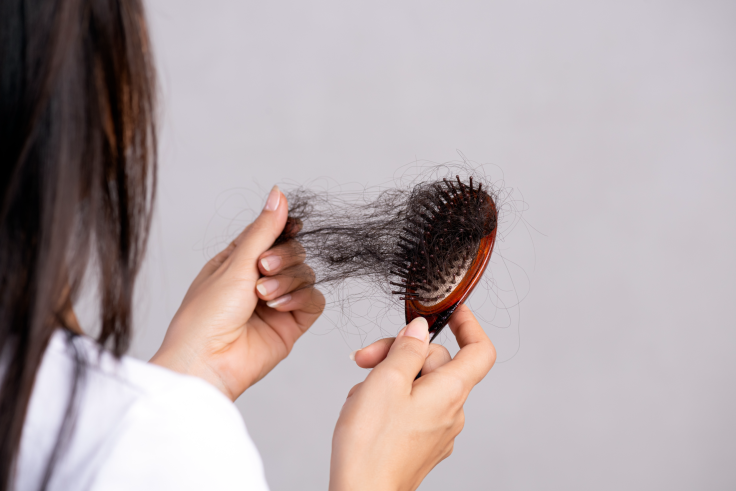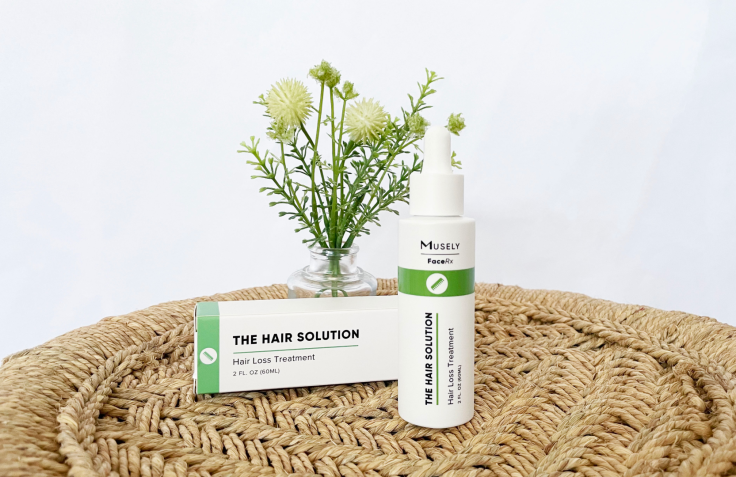Q&A: Female Hair Loss and How to Treat It (According to a Dermatologist)

Thinning hair in women can have a significant impact on self-esteem and mental health. It is estimated that more than 50% of women will experience noticeable hair loss throughout their lifetime, however, the focus remains mostly on male pattern hair loss. This disparity and lack of information surrounding female hair loss have left women with unanswered questions, and many don’t know where to seek help (or even know that help exists). We’ve interviewed Board-Certified Dermatologist, Dr. Brandon Kirsch, to get answers about thinning hair and hair loss in women, how to prevent hair loss, and where to find treatments for hair loss that work.
It seems that the conversation around hair loss is typically geared towards men. Can you explain to our readers the differences between female hair loss and male hair loss?
It is important first to recognize that there are many different reasons for thinning hair. The most common cause is something called pattern hair loss. As we age, this type of hair loss is experienced by the majority of both men (>80%) and women (>50%). However, underlying medical conditions (e.g. thyroid and autoimmune disease), medicines, diet, stress, and illness can cause hair loss as well. An accurate diagnosis of the underlying cause of hair loss is essential, and it is possible to have more than one cause.
In both men and women, pattern hair loss results from progressive miniaturization of the hair follicle and shortening of the growth phase (anagen) of the hair growth cycle. It occurs progressively over many years (especially in women after menopause). Male pattern hair loss is well-recognized by the recession of the frontal hairline and thinning of the hair over the vertex or crown of the scalp. Female pattern hair loss tends to occur with a preserved anterior hairline, evenly diffuse thinning, and an apparent widening of where the hair parts (the so-called “Christmas tree-like” pattern). Infrequently, some women can develop the male pattern as well.

Women can all relate to seeing clumps of hair in their hairbrush or in the shower drain, but when should someone be concerned about the amount of hair they are losing?
While most hair loss is a part of a slow and gradual process, similar to aging in general, acute changes in loss of hair are concerning and should be evaluated by a dermatologist as soon as possible. The amount of normal daily hair loss varies considerably from person to person and is widely estimated for women to be from 50 to 200 hairs. However, many factors will influence the number of hairs lost in a given day (e.g. baseline hair density, frequency of brushing, and washing). Any noticeable increase in the amount of daily hair loss (e.g. going from 50 to 100), or observation of visible thinning warrants further investigation. In addition, while typically done by a dermatologist, anyone can try doing a hair pull test at home. Hold about 60 hairs together in a small bundle and give a slight pull. You should not be able to remove more than 2-4 hairs with gentle traction.
What are the most common types of non-pattern hair loss that readers should be aware of? What do they look like?
By far the most common type of non-pattern hair loss is something called telogen effluvium. It is characterized by excessive, diffuse shedding of the hair. In telogen effluvium, a higher percentage of hair than normal enters the shedding phase (>20%). The transition of hair follicles from the growth (anagen) to the shedding (telogen) phase can occur in response to acute psychological and physiological stress, including surgery, infection, medications and drugs, and nutritional deficiency. Due to hormonal changes that occur during and after pregnancy, postpartum hair loss is common, and women are at increased risk of experiencing telogen effluvium following pregnancy. Telogen effluvium will resolve on its own, although it can take up to 1 year. For those concerned about thinning hair, hair loss treatments are available to slow the rate of shedding and speed up the time to recovery.
For women, in particular, traction alopecia is also especially worth understanding. Traction alopecia occurs from chronic trauma of the hair shaft due to tight braiding and ponytails. Traction alopecia is more likely to occur when chemical relaxers are also used, as these products weaken hair by making it thinner and drier. It usually involves the temples, but it can be found on any area of the scalp where hair is tightly pulled. Traction alopecia can be treated when diagnosed early.
Many older women seem to be also concerned with stunted hair growth. Is it true that it becomes more difficult to grow your hair past a certain length as you age?
The hair cycle can be broadly divided into two main stages: anagen and telogen. Anagen is the growth phase and telogen is the shedding phase. Normally about 90% of your hair is in the growth phase. The longer the length of time a given hair remains in the growth phase, the longer it will grow (typically 2-7 years). There is a lot of individual variability regarding the length of time a person’s hair typically remains in the growth phase, but as we age that phase does shorten for most people. In addition to reducing the growth phase, our hairs tend to miniaturize with age (become thinner). Hair loss treatments for women and men work by extending the length of the growth phase. This results in longer hair but also more hairs in the growth phase relative to the shedding phase, increasing density. They also increase the thickness of individual hairs, which helps to give the appearance of more fullness and body.
You mentioned that female pattern hair loss affects more than half of all women. What are the most common causes of FPHL?
The most common causes of female hair loss are normal aging (in particular post-menopausal hair loss) and hormonal changes. Hormonal changes that occur along with hair loss include irregular periods, acne, and excessive hair growth in unwanted areas (e.g. face, arms, legs).
Among the most common types of hair loss that you mentioned, are all of them treatable? If so, how?
Hair loss can be categorized most broadly as either nonscarring or scarring. Nonscarring hair loss is most often treatable, whereas scarring hair loss cannot be treated, as the hair follicle has been destroyed by the scarring process. Pattern hair loss (including menopausal or post-menopausal hair loss), telogen effluvium, and traction alopecia are all types of nonscarring alopecia. However, most nonscarring types of alopecia will gradually become scarring if left untreated for long enough. For that reason, early intervention with all types of nonscarring hair loss is essential. While there is no hair loss cure, there are certain ingredients that have proven to be effective hair loss treatments for nonscarring alopecia.
Hair loss treatments for women often include the following ingredients:
- Minoxidil is a vasodilator (opens blood vessels to increase flow) that was first used in the 1970s as a pill for the treatment of high blood pressure. Some clever dermatologists observed that patients taking minoxidil grew more hair on their heads (and sometimes other places as well). Taking note of this phenomenon, many dermatologists started to use minoxidil pills to treat hair loss, and the drug was further developed with good results as a topical solution and foam. Minoxidil is believed to increase the proportion of hair follicles in the growth phase, as well as increase follicle weight and density.
- Tretinoin belongs to a well-known class of medications known as retinoids and is a synthetic derivative of Vitamin A. The use of tretinoin alone has been found to be effective at regrowing hair through both the induction of protein synthesis and increasing blood flow. There is evidence that combining minoxidil with tretinoin leads to synergistic benefits.
- Finasteride/Dutasteride: The relationship between hair loss and testosterone was first observed thousands of years ago by Hippocrates, who noticed that castrated males did not develop baldness. Male pattern hair loss also does not occur in men missing the enzyme 5-α reductase. Both finasteride and dutasteride work by inhibiting the action of a type of this enzyme most active in hair follicles. Studies have demonstrated efficacy in hair loss treatment for men and women (women also produce testosterone). Dutasteride is considered to be more potent than finasteride.
- Spironolactone is another antiandrogen treatment with promising observed treatment results, similar to finasteride. However, due to broader antiandrogen effects it is used as a hair loss treatment only in females and should be avoided in women who are pregnant, planning to become pregnant, or nursing.
- Ketoconazole is an antifungal that is commonly used to treat seborrheic dermatitis (dandruff). Studies have shown that combining minoxidil with ketoconazole shampoo increases the effectiveness of treatment. Ketoconazole has anti-inflammatory properties and may also have a local androgen-inhibiting mechanism of action. It is an excellent tool for people who also have signs of inflammation of the scalp (redness, scaling, itching).
We know that finasteride is FDA-approved for male hair loss treatments - is it also safe for women?
Finasteride and dutasteride cannot be used in females of childbearing age (currently capable of having children) unless they are using strict birth control measures. However, they are both often used for the treatment of post-menopausal hair loss in women.

Since changes in the hair are inevitable as we age, should our readers be taking preventative measures well before they experience hair loss?
Preventative measures include a balanced, healthy diet, as well as possible supplementation with vitamin D, biotin, zinc, and iron. Avoid tight braids, ponytails, and hair relaxers as much as possible. In addition, active management of inflammatory conditions of the scalp, such as seborrheic dermatitis (dandruff) is beneficial, since inflammation will increase the likelihood of hair loss. Most importantly, medical intervention at the first sign of thinning hair is critical. Delaying interventions will decrease treatment efficacy, and as previously discussed, the ultimate endpoint of all hair loss is irreversible scarring of the hair follicle.
What product(s) do you recommend as an effective hair loss treatment for women who are looking for hair loss prevention and hair regrowth?
Minoxidil, finasteride, and spironolactone are among the very best agents for treating hair loss in women. As these are prescription medications, they can only be used under the direction of a licensed prescriber. Medical research strongly suggests that patients should combine the use of different therapies for optimal clinical outcomes. One product that I recommend for female hair loss, which incorporates these key ingredients is The Hair Solution from Musely.

How can our readers access these prescription treatments without going to the dermatologist’s office?
One great benefit of The Hair Solution from Musely is that patients can access world-class, board-certified dermatologists from the comfort of their own homes. No need to visit the doctor’s office or the pharmacy! Musely’s telemedicine process easily connects patients with dermatologists and pharmacies. You just complete a 3-minute online medical questionnaire, upload 3 photos, and your assigned dermatologist will review your concerns, create a treatment plan and write your custom prescription. Next, your prescription is transmitted to one of Musely’s partner pharmacies and your medication is freshly compounded and shipped directly to your home.
Lastly, how can users maintain their results and continue improving their anti-aging hair care routine?
The earlier hair loss is addressed with medical care, the better the outcome will be. Consistent, ongoing treatment is also necessary, as there is no hair loss cure. As a result, the hairs that regrow and thicken with treatment will be lost after discontinuation. The Musely team will help monitor your progress and make adjustments as needed to your treatment plan. You can get a jump start on your hair loss prevention routine today at musely.com.



























